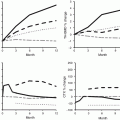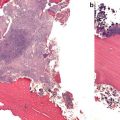Study
Drug
Duration (months)
N
Age (years)
Distal radius
Tb.vBMD or BV/TV
Distal radius
Ct.vBMD
Distal radius
Ct.Th
Burghardt et al. (2010)
Alendronate
24
13
56 ± 4
NS
NS
NS
Placebo
24
20
56 ± 2
NS
NS
NS
Rizzoli et al. (2012)
Alendronate
24
42
64 ± 8
NS
NS
NS
Strontium
24
41
64 ± 8
NS
NS
NS
Seeman et al. (2010)
Alendronate
12
82
61 ± 5
NS
NS
~+2 to 3 %a
Denosumab
12
83
60 ± 6
~0 to +1 %a
~0 to +0.5 %a
~+3 to 4 %a
Placebo
12
82
61 ± 5
~ −2 %a
~ −1.5 %a
~0 to −1 %a
Chapurlat et al. (2013)b
Ibandronate
24
72
63 ± 5
No difference between groups
No difference between groups
No difference between groups
Placebo
24
76
63 ± 5
Bala et al. (2014)
Risedronate (<55 year)
12
112
53 ± 2
−1.60 ± 4.49
NS
Not reported
Placebo (<55 year)
12
49
53 ± 2
−3.61 ± 8.21
NS
Not reported
Risedronate (>55 year)
12
109
62 ± 6
NS
NS
Not reported
Risedronate (>55 year)
12
54
61 ± 4
NS
NS
Not reported
Hansen et al. (2013)
Zoledronic acid
18
33
70 (54–86)
+2.5 ± 5.1 %
NS
NS
PTH(1-34)
18
18
72 (59–80)
NS
−2.4 ± 4.5 %
+2.0 ± 3.8 %
PTH(1-84)
18
20
70 (61–86)
NS
−3.5 ± 3.3 %
NS
Cheung et al. (2014)
Odanacatib
24
109
64 ± 7
+2.57 %a
+0.78 %a
+1.57 %a
Placebo
24
105
64 ± 6
NS
−1.65 %a
−5.28 %a
Schafer et al. (2012)
Ibandronate and PTH(1-84)c
24
43
62 ± 4
+2.26 % (1.37, 3.14)a
−0.76 (−1.33, −0.20)a
−1.90 (−2.61, −1.18)a
Tsai et al. (2014)
PTH(1-34)
12
31
66 ± 8
NS
−1.9 ± 2.8 %
NS
Denosumab
12
33
66 ± 8
+1.3 ± 2.8 %
+0.7 ± 1.4 %
+2.3 ± 4.8
Denosumab and PTH(1-34)
12
30
66 ± 9
+3.1 ± 3.3 %
+1.0 ± 1.6 %
+2.3 ± 4.8
Table 10.2
Effect of antiresorptive therapy on trabecular and cortical density and cortical thickness at the distal tibia, as assessed in vivo by HR-pQCT
Study | Drug | Duration (months) | N | Age (years) | Distal tibia Tb.vBMD or BV/TV | Distal tibia Ct.vBMD | Distal tibia Ct.Th |
|---|---|---|---|---|---|---|---|
Burghardt et al. (2010) | Alendronate | 24 | 13 | 56 ± 4 | ~ +1 to 2 % | NS | ~ +3 to 4 % |
Placebo | 24 | 20 | 56 ± 2 | NS | NS | NS | |
Rizzoli et al. (2012) | Alendronate | 24 | 42 | 64 ± 8 | NS | NS | NS |
Strontium | 24 | 41 | 64 ± 8 | +2.5 ± 5.1 % | +1.4 ± 2.8 % | +6.3 ± 9.5 % | |
Seeman et al. (2010) | Alendronate | 12 | 82 | 61 ± 5 | +0.5 to 1 %a | NS | +4 to 5 %a |
Denosumab | 12 | 83 | 60 ± 6 | +1 to 1.5 %a | +0.5 to 1 %a | +5 to 6 %a | |
Placebo | 12 | 82 | 61 ± 5 | −0.5 to −1 %a | −0.5 to −1 %a | +1 to 2 %a | |
Chapurlat et al. (2013)b | Ibandronate | 24 | 72 | 63 ± 5 | No difference between groups | Greater increase in ibandronate group | Greater increase in ibandronate |
Placebo | 24 | 76 | 63 ± 5 | ||||
Bala et al. (2014) | Risedronate (<55 year) | 12 | 112 | 53 ± 2 | NS | −1.09 ± 2.41 | Not reported |
Placebo (<55 year) | 12 | 49 | 53 ± 2 | NS | NS | Not reported | |
Risedronate (>55 year) | 12 | 109 | 62 ± 6 | NS | NS | Not reported | |
Risedronate (>55 year) | 12 | 54 | 61 ± 4 | +0.40 ± 1.51 | +0.50 ± 1.68 | Not reported | |
Hansen et al. (2013) | Zoledronic acid | 18 | 33 | 70 (54–86) | +2.2 % ± 2.2 % | +1.5 % ± 2.0 | +3.0 ± 3.5 % |
PTH(1-34) | 18 | 18 | 72 (59–80) | +3.3 % ± 5.7 % | −1.6 % ± 4.4 | +3.8 ± 10.4 % | |
PTH(1-84) | 18 | 20 | 70 (61–86) | NS | −4.7 % ± 4.5 | −2.8 ± 4.7 % | |
Cheung et al. (2014) | Odanacatib | 24 | 109 | 64 ± 7 | 2.27 %a | NS | +2.15 %a |
Placebo | 24 | 105 | 64 ± 6 | +0.84a | −1.05 %a | −3.03 %a | |
Schafer et al. (2012) | Ibandronate and PTH(1-84)c | 24 | 43 | 62 ± 4 | +3.22 % (2.35, 4.10)a | NS | NS |
Tsai et al. (2014) | PTH(1-34) | 12 | 31 | 66 ± 8 | NS | −1.6 % ± 1.9 | NS |
Denosumab | 12 | 33 | 66 ± 8 | +2.1 % ± 3.0 | +0.9 % ± 1.2 | +3.3 % ± 3.3 | |
Denosumab and PTH(1-34) | 12 | 30 | 66 ± 9 | +1.6 % ± 2.8 | +1.5 % ± 1.5 | +5.4 % ± 3.9 |
Effect of Antiresorptive Therapy on Trabecular Microarchitecture
Overall, the effect of antiresorptive therapy on trabecular vBMD and microarchitecture varies by treatment, skeletal site, and study. Two years of ibandronate treatment in postmenopausal women with osteopenia did not lead to significant improvement in trabecular vBMD in comparison to the placebo control group at either the distal radius or distal tibia [48]. Similarly, in a placebo-controlled study of postmenopausal women with low bone density, Burghardt et al. reported that 2 years of alendronate therapy also did not change trabecular vBMD at the distal radius [49]. This finding was also observed at the distal radius in two other studies of postmenopausal women treated with alendronate [50, 51]. However, Seeman et al. and Burghardt et al. reported an increase in trabecular vBMD at the distal tibia after 12 and 24 months of alendronate, respectively [49, 51]. Treatments with 12 months of denosumab, 18 months of zoledronic acid, and 24 months of odanacatib in postmenopausal women were all reported to increase trabecular vBMD at both skeletal sites [51–53].
Despite advancements in high-resolution imaging, changes in trabecular microarchitectural parameters in response to antiresorptive therapy have generally not been detected by HR-pQCT [48–54]. The lack of significant findings may be due to limited resolution and/or poor measurement precision relative to the expected change induced by the treatment. Although the reconstructed voxel size is 82 μm for the standard patient HR-pQCT protocol, the actual spatial resolution of the image is approximately 130–140 μm, which is about equal to the width of human trabeculae [55]. Moreover, subtle motion during the scan, more common at the radius than the tibia, can negatively affect the precision of HR-pQCT measurements thereby adding to the challenge of detecting small changes. Indeed, whereas the short-term precision of trabecular density measurements by HR-pQCT is excellent (<1 %), the short-term precision of trabecular microarchitecture measurements is substantially worse (1.8–4.4 %) [9, 10]. Though not routinely used, 3-D registration of follow-up images to the baseline image may improve the ability to detect changes in bone microstructure [56, 57].
A recently developed technique called individual trabecula segmentation (ITS) enables detailed quantification of trabecular morphology (plates or rods) and direct measurements of each individual trabecula [58]. The effect of anabolic therapy on HR-pQCT-based ITS parameters has been reported and thus may be a useful method to characterize other treatment-induced changes in trabecular microarchitecture in the future [59].
Stay updated, free articles. Join our Telegram channel

Full access? Get Clinical Tree






